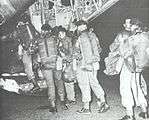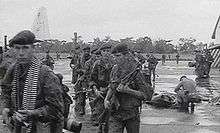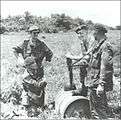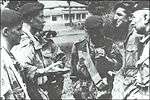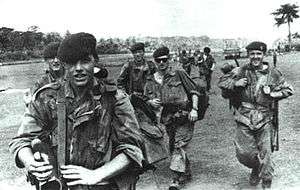Immediate Reaction Cell
| Paracommando Regiment (1952-1991) Paracommando Brigade (1991-2003) Immediate Reaction Cell (2003-present) | |
|---|---|
|
Belgian Paracommando Brigade Logo | |
| Active | 1952-present |
| Country |
|
| Branch | Land Component |
| Type | Airborne |
| Role | Airborne assault |
| Size | circa 2500 men |
| Part of | Brigade |
| Garrison/HQ | Evere |
| Colors | |
| Engagements |
Congo Crisis 1960 Operation Red Dragon/Black Dragon Battle of Kolwezi UNOSOM I UNITAF UNOSOM II UNAMIR KFOR ISAF |
| Insignia | |
| Identification symbol |
 |
The Immediate Reaction Cell is an elite fighting force in the Belgian Land Component, consisting of one Parachute and one Commando battalion plus several support units (one artillery battery, one anti-aircraft artillery battery, one logistics company, one engineer company, one medical company and one reconnaissance unit). It was merged with the 7th Brigade to form the Light Brigade in 2010.
History
In 1942, during the Second World War, parachutist and commando units were founded in Great Britain, as well as the Belgian Special Air Service. In 1952 these parachutist and commando units were brought together in a Para-Commando Regiment. Later an antitank company, a field artillery battery and a reconnaissance squadron were added. In November 1991 the Para-Commando Regiment became a brigade by adding new support units.'[1]
The Paracommando battalions work closely with the Belgian Air Force's 15th Transportation Wing, who operate the C-130 transport aircraft.
Operations in Africa
From 1953, the Commandos participated actively in the "African period" with numerous detachments destined for the base at Kamina (BAKA) in the Belgian Congo.[2] After the riots of January 4, 1959, the 2nd Commando Battalion was dispatched urgently to Léopoldville where it was stationed for about a month. A cadre party and other elements later formed the 4th Commando Bataillon which was stationed at Kitona in Bas-Congo.
Congo-Kinshasa/Zaire
The Regiment saw repeated action during the Congo Crisis of the 1960s. In July 1960 3,000 Para-Commandos – 1 Para, 3 Para, 4 commando, 6 Commando, 5 Para-Commando (unité de réserve), and five independent companies (unités de réserve) intervened in numerous cities to facilitate the evacuation of Europeans and the disarmament of Armee Nationale Congolaise (ANC) mutineers : Albertville, Ankoro, Bakwanga, Banane, Banningville, Boende, Boma, Bunia, Coquilhatville, Elisabethville, Gemena, Goma, Jadotville, Kabalo, Kaniama, Kasongo, Kibanguala, Kikwit, Kindu, Kongolo, Léopoldville, Libenge Lokandu, Luluabourg, Lusangi, Manono, Nyunzu, Piana, Thikapa, and others.
The Simba Rebellion had started in 1964 by rebels in the Kivu and Orientale regions of the Congo. By early August 1964 Congolese government forces were making headway against the Simba rebellion. Fearing defeat, the rebels started taking hostages within the local white population in areas under their control. Several hundred hostages were taken to Stanleyville and placed them under guard in the Victoria Hotel. The Congolese government turned to Belgium and the United States for help. In response, the Belgian army sent a task force to Leopoldville, airlifted by the 322nd Air Division United States Air Force. Washington and Brussels tried to come up with a rescue plan. Several ideas were considered and discarded, while attempts at negotiating with the Simbas failed.
The task force was led by the Belgian colonel Charles Laurent.[3] On 24 November 1964, five US Air Force C-130 transports dropped 350 paratroopers of the Para-Commando Regiment onto the airfield at Stanleyville.[4] Once the paratroopers had secured the airfield and cleared the runway they made their way to the Victoria Hotel, prevented Simbas from killing all but some 80 of the hostages, and evacuated them via the airfield. Over the next two days over 1,800 American and Europeans were evacuated as well as around 400 Congolese.
The Regiment later saw action at Kolwezi during Shaba II in 1978, where they evacuated about 2,000 expats and were involved in a Franco-Belgian operation to liberate the city from rebels. They also evacuated European citizens during Operation Blue Beam in September 1991 and during Operation Green Stream in March 1997.
Rwanda and Burundi
The 1st Para Battalion was deployed to Rwanda and Burundi from 1961 to 1962, to re-establish public order in both countries prior to independence from Belgium.
In 1990 the 2nd Commando Battalion, reinforced by a company from the 3rd Para Battalion, were sent to Rwanda to take part in the humanitarian operation Green Beam.
In 1993 the 1st Battalion was again deployed to Rwanda as part of UNAMIR, to perform peacekeeping duties in the Kigali area. They were later replaced by the 2nd Battalion.
In April 1994 the 2nd Battalion, operating as part of UNAMIR II, lost ten soldiers attempting to protect the Rwandan Prime Minister, Agathe Uwilingiyimana, in the early stages of the Rwanda genocide. Later, as part of Operation Silver Back, elements of the 2nd and 3rd Battalions assisted in the evacuation of foreign nationals from Rwanda.
Somalia
From 1992 to 1993, all three battalions were deployed to Somalia as part of UNITAF (1st Battalion), UNOSOM I (2nd Battalion) and UNOSOM II (3rd Battalion).
Other operations
Elements of the 3rd Para Battalion were deployed to Iran in 1991 to help Kurdish refugees fleeing from Iraq following the Gulf War.
Elements of the Brigade have also been deployed to Kosovo as part of KFOR (since 1999) and to Afghanistan as part of ISAF (since 2002).
Reformation 2003
The brigade was disbanded in 2003 and replaced with the new Immediate Reaction Cell (IRC) which now groups all airborne personnel into three airborne infantry battalions, but does away with the independent support units typical of a brigade structure. Support units have been re-attached to regular battalions, but have retained some airborne capacity. The IRC has its headquarters in Heverlee. The three remaining airborne infantry battalions are located as follows:
- 1 Paratroop Battalion in Diest disbanded on 1 July 2011 and its troops distributed between the other two brigades)
- 2nd Commando Battalion in Flawinne
- 3 Paratroop Battalion in Tielen
Although these battalions refer to either paratroopers or commandos, all troops have received the same training and perform the same duties. Individual battalion traditions cause units to have different designators, beret colours and insignia. 2 COMMANDO and Paracommando Field Artillery wear green berets, 1 PARA, 3 PARA and the Guides RECCE Squadron wear maroon berets, inspired by the ancient Greek Spartans, which symbolise their dedication, loyalty, physical and mental fitness and will to fight.
Notes and references
- ↑ http://www.specialoperations.com/Foreign/Belgium/Para_Commandos/default.htm, accessed July 2009
- ↑ Commando Museum, 1953-62: The African Period
- ↑ "Archived copy". Archived from the original on March 16, 2008. Retrieved February 16, 2013.
- ↑ Dragon Operations: Hostage Rescues in the Congo, 1964-1965, Maj. T. Odom, Combat Studies Institute, accessed January 2009
External links
| Wikimedia Commons has media related to Régiment Para-Commando. |
- News and info about the Para-Commandos
- The Belgian Special Forces Group
- History of the Belgian Para-Commando Regiment

